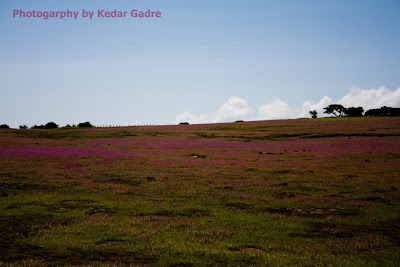http://en.wikipedia.org/wiki/Kaas_plateau.
Kaas is naturally covered on flower beds during Late August and early September weeks, the bloom remains for about 2-3 weeks and is dependent on the preceding monsoon. Sometimes late or errant monsoon may cause shift in period of bloom. En route to Kaas is as beautiful and enchanting as the plateau itself. Green Sahyadri ranges covered in fog and large valleys with backwater from Koyna Project gets you connected with the nature in an instant. Before visiting the place itself I had heard that its a good place to meditate and after visiting the place itself I had no doubt about it. Peace, Calm, Natural Beauty and grounding enormous Sahyadri makes you feel stable and human again (for all those machines working in a city like me). We opted for a study tour conducted by Medha Karkhanis rather than visiting the place on our own, and our decision was wise. The place itself has lots of natural wonders, but not obvious to untrained eyes. Medha helped us understand those wonders and opened our eyes to a forgotten world, the way Nature works. She knew the flowers and plants found in and around Kaas, knew their specialties and showed us few marvels I had always wanted to see myself since I was a child.
You can see the bed of flowers moving with air in the video below,
We saw a flower called Vigna vexillata or locally known as Halunda. The flower has a bright spot on one of its petal where it wants the bee (pollinating agent) to sit or settle. The bright spot attracts the pollinating agent and assures that the pollinating agent would not settle on any other petal. The pressure on that very spot brings out the male stem out of a tiny tube in a way that it would touch the feet of the bee or pollinating agent. The pollinating agent then carries it from one flower to another causing pollination of the flower.
 |
| Vigna vexillata or locally known as Halunda |
You can see a real demo of Vigna vexillata or Halunda in video below (please remember that if you come across this flower dont attempt similar thing on the flowers. This was done only for demonstration purpose to students, and only one flower was tormented during this video clip. If you do this same trick on many flowers, you would be wasting all those flowers' pollens, endangering that species in locality. Learn from nature, but dont harm it on your way to knowledge)
Another interesting plant we observed was Drosera indica. Its a carnivorous plant. I had always imagined these plants to be big in size (thanks to the fairy tales and cartoons portraying such plants). But this one was a tiny one and we would have never discovered it without the company of Medha and couple of her friends who knew these tiny details about the place.
You can see the way plant reacts to anything which come closer to it. On putting a stick near its tentacles, it grabbed hold of it with thin hair on tentacles. We also watched an ant walking on the tentacle, getting trapped by it slowly.
The last one I want to cover is Utricularia purpurascens. Though we did see lot many types of flowers, but I want to cover only those which were unique, rare and had some special characteristics. Utricularia purpurascens is also known as Sitechi Asawe in local language - Marathi. This is also a type of carnivorous plant (the flower looks too cute to be a carnivorous type!). They capture small organisms by means of bladder bladder-like traps. The plants have bladders. When some insect or organism passes by those bladders, the bladder door opens and sucks them in along with water. When the bladder is full, it closes the trap door.
 |
| Utricularia purpurascens or locally known as sitechi asawe |
Overall the place is worth visiting at least once. The sahyadri hill ranges, valleys, back water, abd lovely flower beds refresh and re-energize you. Below are some more pictures of Kaas flowers. Best time to visit is Sep, Oct every year. I recommend the study tour conducted by Medha Karkhanis too. She conducts these tours from Thane, here are her contact details if you are interested -
medhakarkhanis@gmail.com, 09820101869.
My special thanks to @Kedar Gadre for the lovely photographs I have included in this blog.
 |
| Kaas Pathar, Satara - flowers |
 |
| Valley near Kaas, Satara |
 |
| Flower bed, Kaas Plateau |
 |
| Sahyadri ranges near Satara |
 |
| Thoseghar waterfall |

